Nikon AF-S Nikkor 70-200mm f/4G ED VR Lens Review
Nikon AF-S Nikkor 70-200mm f/4G ED VR Performance
At 70mm, sharpness in the centre portion of the frame is outstanding from maximum aperture. Although the clarity towards the edges isn't up to the same level, it is still very good at this aperture and focal length. Stopping down the aperture gradually improves performance across the frame, with peak edge to edge sharpness being achieved at f/11 where sharpness is outstanding across the frame.With the lens zoomed to 105mm, similar high levels of sharpness are achieved in the centre portion of the frame, but the clarity towards the edges falls to good levels towards the edges of the frame. Peak sharpness across the frame is again achieved at f/11.
Finally, at 200mm, sharpness in the centre portion of the frame remains excellent at maximum aperture and the clarity towards the edges of the frame approaches very good levels again. Peak sharpness across the frame is achieved between f/8 and f/11 for this focal length.
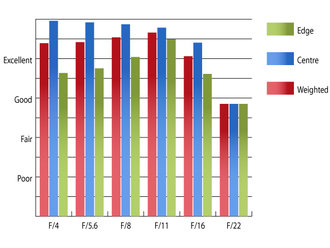 Resolution @ 70mm | 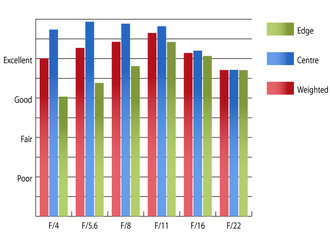 Resolution @ 105mm | |
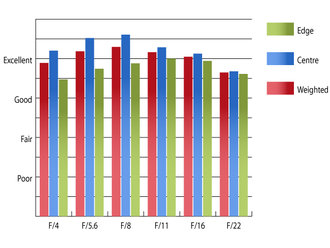 Resolution @ 200mm | How to read our chartsThe blue column represents readings from the centre of the picture frame at the various apertures and the green is from the edges. Averaging them out gives the red weighted column.The scale on the left side is an indication of actual image resolution. The taller the column, the better the lens performance. Simple. For this review, the lens was tested on a Nikon D700 using Imatest. |
Levels of chromatic aberrations are extremely well controlled for a telephoto zoom lens, only just exceeding 0.25 pixel widths throughout most of the zoom range. At 105mm CA levels increase slightly, although this low level of fringing should be difficult to spot, even in very large prints, and harsh crops from the edges of the frame.
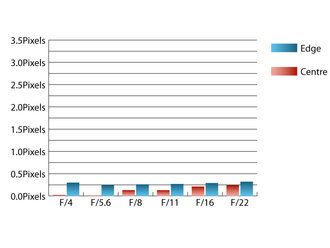 Chromatic aberration @ 70mm | 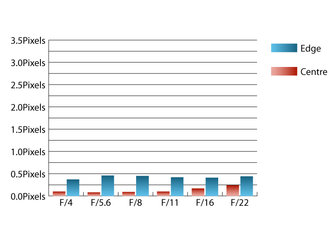 Chromatic aberration @ 105mm | |
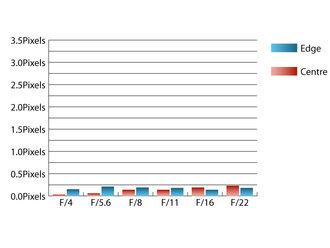 Chromatic aberration @ 200mm | How to read our chartsChromatic aberration is the lens' inability to focus on the sensor or film all colours of visible light at the same point. Severe chromatic aberration gives a noticeable fringing or a halo effect around sharp edges within the picture. It can be cured in software.Apochromatic lenses have special lens elements (aspheric, extra-low dispersion etc) to minimize the problem, hence they usually cost more. For this review, the lens was tested on a Nikon D700 using Imatest. |
Falloff of illumination towards the corners is fairly well controlled for a telephoto zoom lens. At 70mm and maximum aperture the corners are only 0.98stops darker than the image centre and at 200mm the corners are 1.38stops darker. Visually uniform illumination is achieved with the aperture stopped down to f/5.6 or beyond throughout the zoom range.
Imatest only managed to detect 0.149% barrel distortion at 70mm, which is a very mild amount of distortion and shouldn't cause any issues day-to-day. However, at 200mm Imatest detected 2.28% pincushion distortion, which is reaching the levels where it may become noticeable in normal images. If straight lines are paramount, you'll be glad to hear that the distortion pattern is uniform across the frame at both ends of the zoom range, which should make corrections in image editing software afterwards relatively straightforward to apply.
Thanks to Nikon's Nano-crystal coating, incidences of flare and ghosting are very rare indeed. Contrast holds up incredibly well, even when shooting into the light at maximum aperture. A deep circular hood comes supplied with the lens, which does a decent job of shading the lens from extraneous light that may cause issues.
Add your message
Login required
Please login here or if you've not registered, you can register here. Registering is safe, quick and free.
Please login here or if you've not registered, you can register here. Registering is safe, quick and free.
photodo Stats
1102 lenses
428 MTF tests
74 in-depth photodo reviews
100+ users join each day
Help the lens community by reviewing or rating a lens today via our lens search
428 MTF tests
74 in-depth photodo reviews
100+ users join each day
Help the lens community by reviewing or rating a lens today via our lens search
Latest Lens Reviews
- Chinon 28mm f/2.8 Vintage Lens Review
- Canon EF 70-200mm f/4L IS II USM Lens Review
- Samyang AF 85mm f/1.4 EF Review
- Sigma 70mm f/2.8 DG Macro Art Review
- Samyang AF 24mm f/2.8 FE Review
- Meike 50mm f/1.7 Review
- Tamron 70-210mm f/4 Di VC USD Review
- Lensbaby Burnside 35mm f/2.8 Review
- Asahi Super Takumar 50mm f/1.4 Review
- Asahi Super-Multi-Coated Takumar 135mm f/3.5 Review
